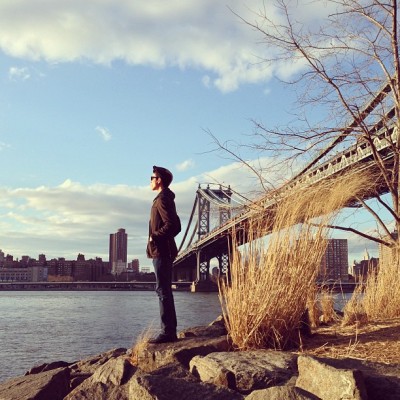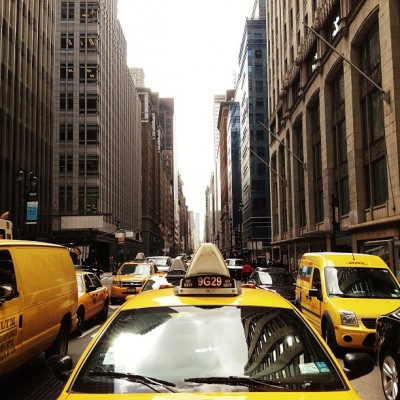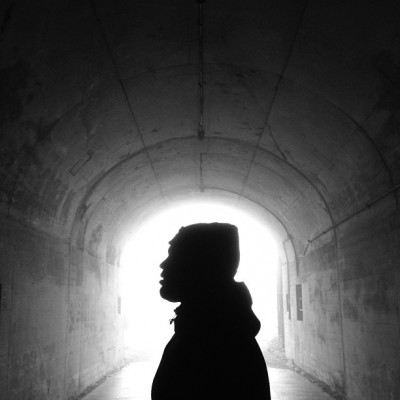ONE LUMINOUS, wintry evening in Dumbo, a small group of vintage-bicycle-riding, leather-jacket-wearing, artisanal-coffee-drinking individuals gather outside the Brooklyn Roasting Co. Although I have never met any of these people, my friend Abbie recognizes several from their Instagram feeds. Abbie is an editor at a D.C. financial paper, but she’s also @abbiemred – a casual but dedicated Instagram user with 4,600 followers. Most of the people lounging in the sun are followers of, or are followed by @abbiemred. Like us, they’re here to ’gram.
Having drained the obligatory espresso, we set off as a cohort: surging towards the water with iPhones in hand – a score or so Instagrammers chasing the sunset. A small vanguard are very focused – splintering off and hightailing it to the old jetty pylons under the Brooklyn bridge, which scatter outwards from the shore in regimented rows – but the photo-taking is consistently collaborative. Instagrammers arrange companions for portraits and silhouettes, share ideas, mix up perspectives, admire each-others’ shots, and make casual conversation.
“But seriously, what’s your favourite song on the new Sigur Ros album?” bubbles a slim Asian guy from California. “And can you pronounce it?” A quick search reveals him to be @devincastro, whose Instagram profile displays 16k followers, a painterly aesthetic, and a tendency to attach song titles to each of his posts.
Everyone in the group is enthused today but one ’grammer, Cubby (@cubbygraham), in flannel and with a scrubby ginger beard, is especially so. Cubby has just moved to the city to work for an H2O non-profit (@charitywater), a move that turned out to be “super-fun!” (For Cubby, everything is “super-fun.”) Later, he will post a picture of a fellow ’grammer silhouetted dramatically against the Financial District skyline, with a bike on his back, and the caption: “Had a RAD-TASTIC Adventure tonight with some old friends & some new ones!” The photo will make it to the popular page and earn 14,136 likes and 284 comments, most of which Cubby will reply to.
~
When Instagram founder Kevin Systrom developed the idea for a smartphone-only photo sharing app in 2010, he likely did not envisage such gatherings. Instagram was designed to enable easy information-sharing amongst existing friends, allowing users to quickly snap photographs and post them to their news feed for their followers (the equivalent of Facebook “friends,” with the distinction that on Instagram, this relationship need not be mutual) to see. Followers can then “like” and comment on images, which are uploaded to adhere to a square frame. Instagram’s (by now characteristic) filter options were added, as Systrom relates in June’s Vanity Fair profile, because his girlfriend was anxious about the artistic merit of her photographs. Add sepia-tone and sun-flare, and voila! – “likes” guaranteed.
Having moved to New York in the summer of 2012, I was immediately stunned by the sheer ubiquity of the iPhone: the loud conversations on the bus; the way friends stood together silently on the 6 train, plugged into headsets; the instinctual drive to reach for a phone to document, to distract, to direct. To me, smartphones seemed like tools of alienation, abstracting the real world; facilitating a weird disconnect between appearance and reality, individual and group—and Instagram did not exist outside of its cats-and-ugly-retro-filters-and-irritating-celebrity-profiles cul-de-sac. I was convinced that “social networks” weakened rather than strengthened any genuine sense of community.
Clearly, I was in a minority. In February 2013, Instagram reached 100 million monthly actual users, and within that vast milieu, a myriad of distinct social tribes jostled for space. The insta-group Abbie introduced me to in Dumbo had evidently managed to bridge the cyber and the real – using the app to forge tangible relationships. “I think of Instagrammers as my people,” Abbie tells me, sheepishly. “It’s lame, but it’s my life.”
~
As soon as we get home from Dumbo, I open an Instagram account. Having added my new acquaintances, I am able to map out relationships in photographs and comment-threads. The in-jokes of shout-outs (“Grabbed coffee with my friend @aaroncatcher tonight”) and hashtags (#anythingforthegram, #bluronpurpose, #fromwhereIstand, #caughtgramming) walk the fine line between personal and public – a register those acclimatized to the intimate-open acoustics of social networks navigate with ease. Emojis colourfully punctuate the text: thumbs-ups, waving hands, grinning faces. Effusive pro-Instagram messages proliferate: “Yesterday I had the pleasure of going on not one but two great photo walks… Joined by some of my all time favourite instagrammers, I was reminded once again just how incredible this app is.” Comments are effortlessly enthusiastic and positive (“Wow!”, “nailed this,” “I love it,” “killa killa!”); an endless volley of un-besmirched benevolence.
So it’s appropriate that the person at the center of this insta-clique is exceptionally affable. Pei Ketron is a compact individual with killer curves, often hidden under casual jeans and t-shirts, and a round face that permanently radiates goodwill: all dimpled smile and crinkled black eyes. Pei works for Lightt (an app that creates kinetic GIF-like images) and moved to New York from San Francisco with her boyfriend Chris in the summer of 2012. @pketron and @chrisconnolly are an Instagram power couple, commanding 1million followers between them: Pei has 545k, Chris 462k – Kevin Systrom, for comparison, has 845k.
“There’s, like, me hanging out with my friends,” Pei tells me, perched on a stool in the window of an East Village café, “and then there’s an Instameet.” The Dumbo adventure was a mixture of the two – Pei planned to shoot with a couple friends, but, having received messages from both Abbie and Cubby, decided to expand the party. Though relatively novel in New York, photo-walks are firmly established in San Francisco. Pei started with Flickr-meets (occasions where enthusiasts of Flickr – an image-hosting website that predates Instagram – would meet to take photos together), which is where she met Chris. With the advent of Instagram, this bubble expanded and friends of friends became incorporated, as the group extended invitations via Instagram comments to local talent. For the couple’s move to New York – necessitated by Chris’s then job at Spotify – Instagram provided a ready-made social group.
This particular group is comprised of designers, photographers and technophiles who use Instagram in an arguably more deliberate way than your average enthusiast. While the app provides them with a forum for dialogue, it also seems to function as a powerful platform for aesthetic demagoguery. Instagram is an inherently restricted platform: pictures must be posted square and simplicity speaks volumes given that they must pique interest in thumbnail form. The hallmarks of Pei & Co.’s photography are symmetry, lucid hues, straight lines, and distant, isolated figures.
While the Instagram crop-and-filter is the extent of your average user’s retouching process, Pei & Co. mine the depths of app-land for editing tools. Snapseed is essential and provides the bulk of colour adjustments, tone, contrast, filter, sharpening; TouchRetouch. clones out distracting elements in the image; ImageStraightener offers pixel-by-pixel straightening (“Best app ever,” Pei tells me. “I’m really obsessed with symmetry and having things lined up.”); Squaready for square-cropping, because it allows minute left-right, up-down corrections. “We actually want to create art in this space,” explains Pei, patiently. “We want to make beautiful things and we’re not going to post things if they don’t look awesome, or at least really interesting, right?”
Whereas most people walking into Café OST might shoot and immediately post a picture tagged to the location, Pei scopes out the scene, carefully photographs the light slanting through large bay windows and hitting the artfully eclectic furnishings, goes home, selects a photo, meticulously edits and finally posts it several hours later. “So we both come here at the same time but we shoot entirely different things, post it at different times and are telling people different things about our daily activity,” she summarizes. “It’s like, ‘Hey, I hung out with this person, and the light is beautiful, the space is beautiful’, or like, ‘Hey, I’m drinking an iced coffee, look at my iced coffee.’”
~
For all her reference to two polarized groups – the “serious” users versus the rest – Pei hates the air of inaccessibility that has accrued to her social circle. “The annoying thing about Instagram is that people start to feel,” she pauses, marshalling her words carefully, “excluded. It becomes like, instafamous, the Instagram elite….” She’s sick of the media publishing articles titled ‘Top Ten Instagram Users You Should Follow,’ which exacerbates this sense of exclusivity. “There’s a lot of instadrama,” she sighs. “These people I happen to be friends with happen to have a lot of followers. It’s not like I’m choosing friends based on how many followers they have. That’s just who I know.”
Nevertheless, once one reaches Pei’s level of exposure, it becomes a matter of necessity to carve out a manageable cyber-social-space. “We have to self-limit,” she admits. Both she and Chris ration the number of people they follow to avoid being “overwhelmed”: Pei’s max is 200, and Chris’s is half that. She is more invested in building relationships, whereas he will ruthlessly cut out close friends he deems not worth following. Pei used to methodically check each comment, but nowadays her newsfeed is dramatically different from “a normal person’s,” and this is impossible.
This ethos of order applies to the rest of Pei’s online activity. She is, by her own admittance, a social-media obsessive – although she distrusts Facebook and is now using Path (a similar site, which limits the number of friends one can have to 150, to facilitate the maintenance of close relationships). She has allotted to each app a particular usage. “The way that I think about it – and we’ve talked about this as a group – is, Instagram is for the top shots. These are the really fantastic, artsy, beautiful, interesting shots. What we’ve started using Path for is a lot of nice shots, fun shots, people, personal shots—that aren’t quite the quality of what we want to put on Instagram. And for Twitter we do the throwaway shit-shots.”
In relegating less-than-perfect, personal shots to other forums, Pei & Co. ensure an austerely elegant Instagram feed, and in doing so attract cohorts of awestruck followers. Statistic-crowded profile displays mean that Instagram can quickly become a numbers-game. “Chris and I both talk about having a benchmark for a successful photo,” says Pei, “We try to think about averages. I was averaging 7,000 likes a photo, but now I’m averaging four or five [thousand], even though I have a lot more followers.”
This number crunching is not mere egotism. Instagram has become a marketplace—both for businesses and individuals. Brands and companies are soliciting influential Instagram users for their reach and endorsement, says Pei. “They’re looking at those numbers—how big is your audience?” This is hardly surprising. In the spring of 2012 Instagram was sold to Facebook for $1 billion; the app’s promotional capacity is impressive, its potential commercial value huge. As Systrom points out in Vanity Fair, the app’s creators quickly realized “Instagram could be far more than photo-sharing.” Facebook recently announced that Instagram will start integrating add-space in 2014, but companies as diverse as Nike, Gillette and Mercedes-Benz have already co-opted the app for marketing purposes, rewarding powerful users for incorporating their products into ’grams.
Pei is picky, however, when it comes to these job offers – she is unwilling to do anything that will pollute her image (tourism bureau deals to fund overseas trips in exchange for gorgeous holiday snaps, are, she says, the best: “Not only do you get a trip but its also a little hands-off your feed”). As @pketron, she’s effectively managing a community and is dedicated to providing good content to her followers. And despite her online fame, Pei is self-deprecating. She very much enjoys living in New York: being “anonymous in this huge sea of people.”
As we leave the café, Pei shoots a portrait of me. I wander with her to her regular printing store in the East Village, where she collects several Instagram photos for a customer. There is a sense of wonder as she holds the enlarged, square images in her hands.
~
Later that evening, my roommate bounds into my room, squealing, and thrusts her iPhone under my nose. @pketron has posted my portrait. After 38 minutes, the photo has 1,357 likes. I am suddenly nervous: I want to be a success for Pei—she had said that portraits generally performed poorly, and I am mindful of her 4,000-like benchmark. By the next morning the picture has 5,394 likes (after two weeks these plateau at 6,669). I reflexively check my portrait every three minutes or so: scrolling through comments, tallying likes. My number of followers quadruples almost instantaneously, despite the fact I have zero photographs. It’s official: I’m instafamous.
This endless anxiety over popularity and perceived success, the need for validation via likes, is clearly exhausting for long-term users (although the idea of long-term has a very different meaning in the context of apps; when I ask a user how long Hipstamatic, former favourite app of the iPhoneography set, was big, she replies, “Pretty long…almost a year”). Hanging out with Pei and some of her closest friends—Heidi (@badxtzo, an Urban Outfitters HR manager), Patty (@patriciaj, proprieter of tiki bar Otto’s Shrunken Head), and Shah (an Iranian-Norwegian currently on an Instagram break) – one senses a surprising ambivalence towards the app.
“People delete their photos if they don’t get enough likes,” says Shah in bewilderment. “They all start in very different places, then they meet somewhere in the middle. The app loses its meaning when all its users converge.” And people don’t just mimic composition, they also chase down locations. “If we go somewhere, other people will want to go there,” Patty says, with a sigh. The app is an influential disseminator of taste – an echo chamber; the visual equivalent of Twitter. The same tones, the same subjects, the same perspectives—almost exactly the same photograph in some cases—are repeated, and certain Instagram-iconic New York landscapes recur ad nauseum.
“I’m tired of seeing the same shit over and over again,” Pei admits. The group finds it difficult to find new people to follow, but can’t quite endorse extreme innovative measures (surrealist profiles they term “more digital art” than photography, and the #collab trend whereby users swap photographs and edit each-others’ is gimmicky). Shah vetoes street photography, ruling that Instagram is not the right platform. “I feel like it needs to be personal,” he explains. “I get sick of sharing all the time. I feel like I need to disconnect from my phone, and therefore from Instagram.”
Patty shrugs. “We’re all into film now.” She rhapsodizes over the comparative quality of analogue, the lack of editing required, the gratification of creating a physical photograph. “Plus we’re old, so we grew up like that,” she adds. The group’s members – in their 30s – are hardly old, but they were the first generation of Instagram users, and their about-face smacks of nostalgia. Many of their cameras veer into retro territory: Pei’s current favorite is a 1958 Hasselblad. Digital, it seems, offers too much choice—an endless angst over which shot to choose, and how to adapt it. “It degrades the moment,” Patty says, definitively.
Despite this disillusionment, Instagram still inspires impassioned debate. Everyone the friends talk about is an insta-acquaintance, and they acknowledge how central the app has been to their lives. “It brought back a love of photography for us,” says Patty. “And it made photography social,” chips in Pei. “It’s kinda like any app that’s new,” Patty (an app-junkie) summarizes – the novelty wears off. “Someone said it may have, like, served its purpose,” Shah posits. “I think it’s for someone else now.”
~
Feeling the pressure from my 60-odd followers, I end up messing around on Snapseed and posting two pictures in a sleep-deprived stupor at around 2am on a weeknight; a strategically useless time to post in terms of harvesting likes. The photos aren’t very good, and I am excruciatingly aware that both qualify for Shah’s black book of contraband images, involving as they do bridges, sunsets, graffiti and street photography. Despite this, I enthusiastically check how they’re doing as soon as I wake up and feel a thrill of satisfaction each time they receive a like or a comment.
I also narcissistically keep an eye on Pei’s portrait of me. One comment brashly states, “Pretty sure this is the girl I want to marry,” from a gentleman named @jamesrockwell. Pei makes the logistical leap to set me up with said Instagrammer, whom she doesn’t actually know but who clearly is a real person from his feed – plus he met Cubby just last week via an open invitation Cubby made to the Instagram community to grab a coffee. And Cubby in his super-enthusiastic way confirms that James is a “cool dude.” So despite the fact that James cannot yet consume alcohol legally (but spurred on by Pei’s assurances that there are plenty of Instacouples), I consent to an outing.
~
The location James suggests for a rendezvous is Kaffe1668 in Tribeca, which some Googling suggests offers a Macrobiotic Lunch Box involving “lemon-massaged kale.” By the time I arrive, James – in jeans, stubble, flannel, and Wayfarer-style prescription glasses – is nursing an Indonesian Eko Java espresso. Having moved to the city to study film, he soon dropped out and plans to do an intensive graphic design course. Like Pei, he’s convinced that “there’s two kinds of Instagrammer,” and having only recently thrown in his lot with the fancier kind, he is enthused to suddenly see symmetry everywhere.
His transformation from lay-Instagrammer to aspiring Insta-elite occurred just last month and occasioned intensive soul-searching. “I un-followed everyone and started again,” he says, earnestly. “I went through every picture I thought sucked, and out of 400 photos I deleted about 360 of them. One by one. It took about three hours. It was quite a process. You can imagine…going through the last year of your life and kinda wondering ‘who am I?’”
He now follows about 100 people, 90 percent of whom are “very good Instagrammers,” but he is careful not to take it too seriously. “All I’m doing is using it to keep my creativity up,” he explains. “It leaks into other fields I’m interested in, and it made me look at other forms of art differently.” Although he’d like a couple more followers, he is skeptical of conscious efforts to attract them by liking or commenting on photos. “It makes me feel dirty,” he laughs.
James suspects, though, that improving his numbers might be useful in terms of meeting other Instagrammers. This is hard at the moment because, the way he sees it, Instagrammers communicate freely only within distinct follower-blocks. “I have 700 followers,” he says, “and the norm if you’re gonna meet people is like a thousand.” Certainly, James has none of the self-restraint of the higher echelons: he posts frequently and hashtags enthusiastically. I consider telling him this is a mark of amateurism, but decide against it because I don’t want to kill his buzz.
As we walk, he takes photos of the striated, soaring steel-and-glass of the Financial District, a nicely symmetrical tunnel-like pedestrian overpass, a perfectly proportioned Grecian bandstand, and a spiral staircase pleasingly demonstrating the Golden Ratio. All of which later tessellate across my news feed, refracted through various filters.
~
The last time I see Pei is quite by chance. I run into her at a dimly lit, speakeasy-style cocktail bar in Alphabet City on her final night in New York. Tomorrow she and Chris will begin a ten-day road trip back to San Francisco, where Chris has been offered a dream job: designing software for Instagram. Glancing at her group, I’m convinced practically every power-Instagrammer in the city is here; a round-table of aesthetes and technophiles, linked solely by their love of smartphones and their capacity for curation.
At the end of the evening I bustle up self-consciously to say goodbye, disrupting Pei’s animated discussion with a tall, dark-haired man. The next morning, she sends me a chatty email, explaining that the man she was speaking with when I interrupted her was the founder of Instagram, Kevin Systrom.
For Pei, Instagram and everyday life cohere seamlessly. The real and the virtual co-exist—the one layered over the other. Like a vivifying filter over a banal snapshot, the app adds colour and curiosity to the quotidian. “It keeps our lives interesting,” she says, simply. But the more I see real life compressed and collated—neatly, neurotically—into bite-sized squares of perfection on my iPhone’s LED screen, the less I feel like I’m really living.
The endless, intoxicating stream of #instalunch #instafashion #instamoment #instadaily makes one wonder whether the photo is a side project, or whether life itself is merely the means to a photogenic end. Pei & Co. seemingly manage to use Instagram to drill deeper into reality, to mine each experience for aesthetic gems, to form genuine connections—but I still feel the strange slippage of real and virtual; different layers of life jostling for supremacy.
I resolve to delete Instagram. Then I post another photo.











Truly when someone doesn’t understand afterward its up to other people that they will
assist, so here it takes place.